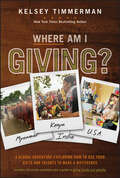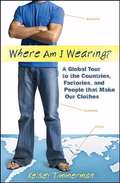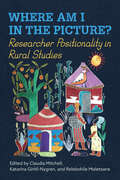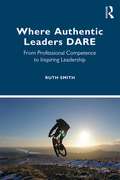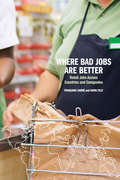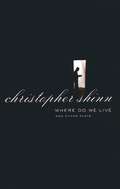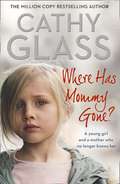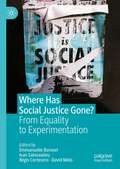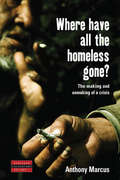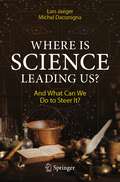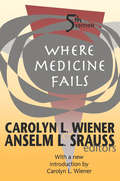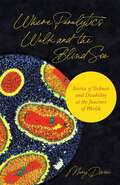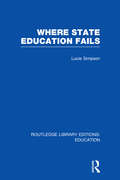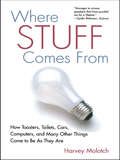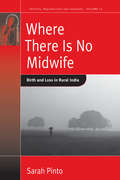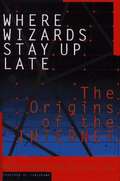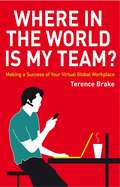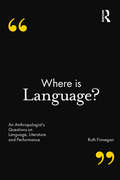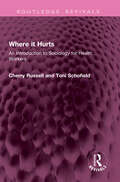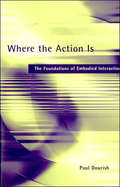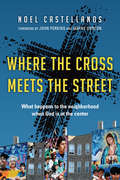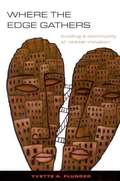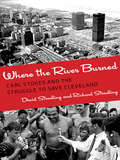- Table View
- List View
Where Am I Giving: A Global Adventure Exploring How To Use Your Gifts And Talents To Make A Difference (Where am I?)
by Kelsey TimmermanYour gifts connect you to a world of giving Americans are generous with their pocketbooks, but trying to make a difference and actually making a difference are two different things. Where Am I Giving? by New York Times bestselling author Kelsey Timmerman takes you on a journey to meet people who will inspire you to live a purpose-filled, generous life and make the greatest impact you can through your career, time, consumer dollars, and donations. Starting in his hometown of Muncie, Indiana, and then traveling all over the world (Myanmar, Kenya, India, Nepal, and more), Kelsey explores not only different ways of giving—as a worker, consumer, volunteer, giver, local and global citizen—but also the benefits and effectiveness of these methods. He spends time with monks, students, a refugee, a Marine, a former Hollywood executive, Peace Corps Volunteers, and seasoned aid workers to explore how they give, as well as with the people on the receiving end of their giving. Along the way he struggles to be a more informed giver as he becomes a "voluntourist,” starts his own local non-profit, and searches for a balance between rationality and passion in how he gives. This book will help you: Reveal the amazing opportunities you have to make an impact using your own gifts—and it doesn't have to be money Understand the sociology, philosophy, anthropology, and neuroscience of giving See how giving can make you more connected and happier Examine types of giving, including microlending, volunteering, donating, ethical consumption, mission trips, voluntourism, child sponsorship, etc. Dive into a nuanced view of effectiveness of international aid and its intersection with development, politics, and culture Where Am I Giving? is a fast-paced narrative combining compelling stories collected over 15 years of travel to 90+ countries, mixed with practical advice on how to make giving a part of our everyday lives.
Where Am I Wearing?: A Global Tour to the Countries, Factories, and People That Make Our Clothes
by Kelsey TimmermanGlobalization makes it difficult to know where the things you buy come from. Journalist and travel writer Kelsey Timmerman wanted to know where his clothes came from and who made them, so he traveled from Honduras to Bangladesh to Cambodia to China and back. Along the way, he met the people who made his favorite clothes and learned as much about them as he did about globalization itself. Enlightening and controversial at once, this book puts a human face on globalization.
Where Am I in the Picture?: Researcher Positionality in Rural Studies
by Claudia Mitchell Relebohile Moletsane Katarina Giritli-NygrenPositionality and researcher reflexivity – how to account for one’s subject position – remain as challenges for new researchers. But they also remain as challenges for experienced researchers, who are often involved in multiple research projects simultaneously. Where Am I in the Picture? sheds light on the idea of researcher positionality through visual methodologies, particularly in the context of studying rurality in Canada, Sweden, and South Africa. The book is intended for new and experienced researchers seeking to decolonize their own perspectives in research in the social sciences and humanities. It incorporates photographs, drawings, and memory work to highlight the social constructedness of what counts as rural. Drawing together compelling narratives from researchers about their positionality in studying rurality, the book highlights a need for greater attention to “where we are in the picture” more broadly. It suggests that when it comes to the rural, researchers need to rethink the interplay of dominant images, insider and outsider perspectives, and what this interplay means in relation to interpretation. Where Am I in the Picture? presents a new vision of how to take into consideration positionality in research.
Where Authentic Leaders DARE: From Professional Competence to Inspiring Leadership
by Ruth SmithThis book demonstrates, complete with practical exercises, how to be successful in both your work and your personal life by becoming a truly authentic leader and empathic influencer. Above all, it shows you how to do this with the positive intention of successful, connected communication and through honouring the other person’s perspective. The book is of particular value to managers and leaders who are very proficient in their areas of expertise and are looking for ways to improve team and personal performance further by developing their leadership and authentic influencing skills. The book provides you with: Clear reasons why authentic leadership and empathic influencing will help in work and personal relationships. How to develop these influencing skills and remain authentic. The evidence, including the relevant neuroscience, as to why this is important. A 'how to' guide. If you are looking for some practical exercises to help develop authentic leadership, then you can go straight here.
Where Bad Jobs Are Better: Retail Jobs Across Countries and Companies
by Francoise Carre Chris TillyRetail is now the largest employer in the United States. For the most part, retail jobs are “bad jobs” characterized by low wages, unpredictable work schedules, and few opportunities for advancement. However, labor experts Françoise Carré and Chris Tilly show that these conditions are not inevitable. In Where Bad Jobs Are Better, they investigate retail work across different industries and seven countries to demonstrate that better retail jobs are not just possible, but already exist. By carefully analyzing the factors that lead to more desirable retail jobs, Where Bad Jobs Are Better charts a path to improving job quality for all low-wage jobs. In surveying retail work across the United States, Carré and Tilly find that the majority of retail workers receive low pay and nearly half work part-time, which contributes to high turnover and low productivity. Jobs staffed predominantly by women, such as grocery store cashiers, pay even less than retail jobs in male-dominated fields, such as consumer electronics. Yet, when comparing these jobs to similar positions in Western Europe, Carré and Tilly find surprising differences. In France, though supermarket cashiers perform essentially the same work as cashiers in the United States, they receive higher pay, are mostly full-time, and experience lower turnover and higher productivity. And unlike the United States, where many retail employees are subject to unpredictable schedules, in Germany, retailers are required by law to provide their employees notice of work schedules six months in advance. The authors show that disparities in job quality are largely the result of differing social norms and national institutions. For instance, weak labor regulations and the decline of unions in the United States have enabled retailers to cut labor costs aggressively in ways that depress wages and discourage full-time work. On the other hand, higher minimum wages, greater government regulation of work schedules, and stronger collective bargaining through unions and works councils have improved the quality of retail jobs in Europe. As retail and service work continue to expand, American employers and policymakers will have to decide the extent to which these jobs will be good or bad. Where Bad Jobs Are Better shows how stronger rules and regulations can improve the lives of retail workers and boost the quality of low-wage jobs across the board.
Where Do We Live and Other Plays
by Christopher ShinnThis anthology marks the emergence of one of the finest and most innovative new artists writing for the theater today. "The secret of Shinn's success is in the way he exploits the dramatic gap between what is said and that which is left unsaid . . . writing like this is rare," said the London Independent. Where Do We Live, the title play, was written shortly after 9/11 and though never referenced, it still haunts this chronicle of the struggles of several aspiring and gifted young New Yorkers on the Lower East Side. Like all his work, it is a deeply affecting story of how we define our lives and our place in the world.The Coming World "Shinn certainly looks like a shining prospect for the future."--Daily TelegraphFour "Nothing is simple emotionally. The play keeps delivering small shocks and aches that end in a standoff, or maybe in that pause between despair, resignation and a twinge of hope. Haunting."--Margo Jefferson, The New York TimesOther People "Shinn writes with graceful compassion about people trapped inside their own skins unable to make sense of their lives."--The GuardianWhat Didn't Happen ". . . is about the distance between people, and the ways in which even friends, spouses and lovers are ultimately unknowable to one another . . . a playwright to cherish."--The New York TimesChristopher Shinn's plays have been produced at Playwrights Horizons, Manhattan Theatre Club, the Vineyard Theatre in New York and often at London's Royal Court Theatre. Where Do We Live received a 2003 Olivier Award nomination for most promising playwright. His next play, On the Mountain, premieres in New York City early in 2005.
Where Has Mummy Gone?: A young girl and a mother who no longer knows her
by Cathy Glass<p>The true story of Melody, aged 8, the last of five siblings to be taken from her drug dependent single mother and brought into care. <p>When Cathy is told about Melody’s terrible childhood, she is sure she’s heard it all before. But it isn’t long before she feels there is more going on than she or the social services are aware of. Although Melody is angry at having to leave her mother, as many children coming into care are, she also worries about her obsessively – far more than is usual. Amanda, Melody’s mother, is also angry and takes it out on Cathy at contact, which again is something Cathy has experienced before. Yet there is a lost and vulnerable look about Amanda, and Cathy starts to see why Melody worries about her and feels she needs looking after. <p>When Amanda misses contact, it is assumed she has forgotten, but nothing could have been further from the truth…</p>
Where Has Social Justice Gone?: From Equality to Experimentation
by Emmanuelle Barozet Ivan Sainsaulieu Régis Cortesero David MéloThis book uses survey data in "hot spots" around the globe, to analyse various models of social justice, particularly the principle of equality, from a pragmatic perspective. Starting with ordinary actors, social movements, and concrete contexts, the authors question foundations of social and political democracy in our times. They focus on how social actors deal with the principles of justice and judgments of justice at work and in their social lives. The book suggests that the increase in social inequalities in recent decades contrasts with the blurring of the aims of social justice. At a time when the reconsideration of politics largely depends on its relevance to and aspirations for social justice, the authors of this book question contemporary developments by illustrating its variety, according to specific historical, institutional, social and organizational contexts.The book will be useful to students and scholars in the social sciences, especially those interested in moral questions regarding social justice, from an empirical and practical point of view.
Where Have All The Homeless Gone?
by Anthony MarcusFor a decade, from 1983 to 1993, homelessness was a major concern in the United States. In 1994, this public concern suddenly disappeared, without any significant reduction in the number of people without proper housing. By examining the making and unmaking of a homeless crisis, this book explores how public understandings of what constitutes a social crisis are shaped. Drawing on five years of ethnographic research in New York City with African Americans and Latinos living in poverty, Where Have All the Homeless Gone? reveals that the homeless "crisis" was driven as much by political misrepresentations of poverty, race, and social difference, as the housing, unemployment, and healthcare problems that caused homelessness and continue to plague American cities.
Where Is Science Leading Us?: And What Can We Do to Steer It?
by Lars Jaeger Michel DacorognaThis book charts the evolution of the sciences and technologies that have shaped our modern age like nothing else in the last 60 years. As well as describing many exciting developments, it will also highlight the challenges and dangers of the technologies that have emerged from them. While science and technology have brought about enormous and often astonishing improvements in our quality of life, they have often also brought with them considerable risks, including the risk of human extinction. We place particular emphasis on the aspects that directly impact us as human beings: Artificial Intelligence (AI), enhancements of our brains/minds through innovative neuro-technologies, and the integration of nanotechnology into our bodies for early disease detection and elimination. What philosophical implications arise from these transformations? Authored by two theoretical physicists who are also experts in economics and capital markets - a rather rare combination - the book will explain the developments of modern science and the resulting technologies. It also examines the current state of play and emerging developments in a manner accessible to non-scientists. Based on their own experience and the analysis, the authors also propose ways in which science can progress more harmoniously in future.
Where Medicine Fails (Society Bks.)
by Anselm L Strauss Carolyn L. WienerThis fifth edition of Where Medicine Fails, like previous editions, argues for a broader definition of society's responsibilities to the ill than is commonly perceived to be the case. The authors examine the moral and economic implications of medical technology, especially in regard to fetal tissue transplant, cancer survival, childbirth, and dying, and provide a thoughtful assessment of the issues and challenges facing American hospitals. Seventeen chapters are new to this edition. The aim of this volume is to encourage serious examination of the current structure of health services and of the complicated facets of health care reform.
Where Paralytics Walk and the Blind See: Stories of Sickness and Disability at the Juncture of Worlds
by Mary DunnAn exploration of early modern accounts of sickness and disability—and what they tell us about our own approach to bodily differenceIn our age of biomedicine, society often treats sickness and disability as problems in need of solution. Phenomena of embodied difference, however, have not always been seen in terms of lack and loss. Where Paralytics Walk and the Blind See explores the case of early modern Catholic Canada under French rule and shows it to be a period rich with alternative understandings of infirmity, disease, and death. Counternarratives to our contemporary assumptions, these early modern stories invite us to creatively imagine ways of living meaningfully with embodied difference today.At the heart of Dunn’s account are a range of historical sources: Jesuit stories of illness in New France, an account of Canada’s first hospital, the hagiographic vita of Catherine de Saint-Augustin, and tales of miraculous healings wrought by a dead Franciscan friar. In an early modern world that subscribed to a Christian view of salvation, both sickness and disability held significance for more than the body, opening opportunities for virtue, charity, and even redemption. Dunn demonstrates that when these reflections collide with modern thinking, the effect is a certain kind of freedom to reimagine what sickness and disability might mean to us.Reminding us that the meanings we make of embodied difference are historically conditioned, Where Paralytics Walk and the Blind See makes a forceful case for the role of history in broadening our imagination.
Where State Education Fails (Routledge Library Editions: Education)
by Lucie SimpsonDespite being published in the early part of the twentieth century many of the issues this volume discusses are still being debated in education today. The author maintains that state education is not functioning as it should – that the output is not commensurate with the outlay, that education has become too narrow in its focus and that more importance should be given to the teaching of younger children. The balance between a traditional academic education versus the skills needed for practical trades is also discussed, as is the disparity between the types of education available to rich and poor.
Where Stuff Comes From: How Toasters, Toilets, Cars, Computers and Many Other Things Come To Be As They Are
by Harvey MolotchMolotch takes us on a fascinating exploration into the worlds of technology, design, corporate and popular culture. We now see how corporations, designers, retailers, advertisers, and other middle-men influence what a thing can be and how it is made. We see the way goods link into ordinary life as well as vast systems of consumption, economic and political operation. The book is a meditation into the meaning of the stuff in our lives and what that stuff says about us.
Where There Is No Midwife: Birth and Loss in Rural India (Fertility, Reproduction and Sexuality: Social and Cultural Perspectives #10)
by Sarah PintoIn the Sitapurdistrict of Uttar Pradesh, an agricultural region with high rates of infant mortality, maternal health services are poor while family planning efforts are intensive. By following the daily lives of women in this setting, the author considers the women's own experiences of birth and infant death, their ways of making-do, and the hierarchies they create and contend with. This book develops an approach to the care that focuses on emotion, domestic spaces, illicit and extra-institutional biomedicine, and household and neighborly relations that these women are able to access. It shows that, as part of the concatenation of affect and access, globalized moralities about reproduction are dependent on ambiguous ideas about caste. Through the unfolding of birth and death, a new vision of "untouchability" emerges that is integral to visions of progress.
Where Wizards Stay Up Late: The Origins of the Internet
by Katie Hafner Matthew Lyon"A little more than twenty-five years ago, computer networks did not exist anywhere - except in the minds of a handful of computer scientists. In the late 1960s, the Defense Department's Advanced Research Projects Agency funded a project to create computer communication among its university-based researchers. The experiment was inspired by J. C. R. Licklider, a brilliant scientist from MIT. At a time when computers were generally regarded as nothing more than giant calculators, Licklider saw their potential as communications devices." "Where Wizards Stay Up Late is the story of the small group of researchers and engineers whose invention, daring in its day, became the foundation for the Internet. With ARPA's backing, Licklider and others began the quest for a way to connect computers across the country." "In 1969, ARPA awarded the contract to build the most integral piece of this network - a computerized switch called the Interface Message Processor, or IMP - to Bolt Beranek and Newman (BBN), a small Cambridge, Massachusetts, company. A half-dozen engineers at BBN, who called themselves the IMP Guys, knew it was possible to do what larger companies - including AT&T and IBM - had dismissed as impossible. But making computer networking possible required inventing new technologies. Working around the clock, the IMP Guys met a tight deadline, and the first IMP was installed at UCLA nine months after the contract award." "A nationwide network called the ARPANET grew from four initial sites. Protocols were developed, and along the way a series of accidental discoveries were made, not the least of which was e-mail. Almost immediately, e-mail became the most popular feature of the Net and the "@" sign became lodged in the iconography of our times. The ARPANET continued to grow, then merged with other computer networks to become today's Internet. In 1990, the ARPANET itself was shut down, fully merged by then with the Internet it had spawned.
Where in the World is My Team
by Terence BrakeAs the economy becomes increasingly global, businesses need employees who can work in teams that cross borders and transcend physical spaces. In Where in the World Is My Team, fictional character Will Williams shares entertaining anecdotes and practical advice to accustom readers to the challenges of a global, virtual workplace. This easy-to-follow guide, ideal for managers and those interested in succeeding in a global economy, introduces new technologies but focuses especially on the six Key Performance Zones for global team collaboration with briefing report summaries to emphasize key points.
Where is Language?: An Anthropologist's Questions on Language, Literature and Performance (Criminal Practice Ser.)
by Ruth FinneganLanguage is central to human experience and our understanding of who we are, whether written or unwritten, sung or spoken. But what is language and how do we record it? Where does it reside? Does it exist and evolve within written sources, in performance, in the mind or in speech? For too long, ethnographic, aesthetic and sociolinguistic studies of language have remained apart from analyses emerging from traditions such as literature and performance. Where is Language? argues for a more complex and contextualized understanding of language across this range of disciplines, engaging with key issues, including orality, literacy, narrative, ideology, performance and the human communities in which these take place. Eminent anthropologist Ruth Finnegan draws together a lifetime of ethnographic case studies, reading and personal commentary to explore the roles and nature of language in cultures across the world, from West Africa to the South Pacific. By combining research and reflections, Finnegan discusses the multi-modality of language to provide an account not simply of vocabulary and grammar, but one which questions the importance of cultural settings and the essence of human communication itself.
Where is the Good in the World?: Ethical Life between Social Theory and Philosophy (WYSE Series in Social Anthropology #12)
by Joel Robbins David Henig, Anna StrhanBringing together contributions from anthropology, sociology, religious studies, and philosophy, along with ethnographic case studies from diverse settings, this volume explores how different disciplinary perspectives on the good might engage with and enrich each other. The chapters examine how people realize the good in social life, exploring how ethics and values relate to forms of suffering, power and inequality, and, in doing so, demonstrate how focusing on the good enhances social theory. This is the first interdisciplinary engagement with what it means to study the good as a fundamental aspect of social life.
Where is the Good in the World?: Ethical Life between Social Theory and Philosophy (WYSE Series in Social Anthropology #12)
by Joel Robbins David Henig, Anna StrhanBringing together contributions from anthropology, sociology, religious studies, and philosophy, along with ethnographic case studies from diverse settings, this volume explores how different disciplinary perspectives on the good might engage with and enrich each other. The chapters examine how people realize the good in social life, exploring how ethics and values relate to forms of suffering, power and inequality, and, in doing so, demonstrate how focusing on the good enhances social theory. This is the first interdisciplinary engagement with what it means to study the good as a fundamental aspect of social life.
Where it Hurts: An Introduction to Sociology for Health Workers (Routledge Revivals)
by Toni Schofield Cherry RussellFirst published in 1986, Where it hurts provides a straightforward and accessible introduction to sociology for beginning students. In dealing with key areas of sociology (such as class, gender, race and ethnicity, age, work, and the state) and grounding theory and concepts in real issues, it demonstrates how sociology works in a specific application- the social history of health and health care.Students for whom sociology is part of a health or welfare-related course will find this a lively and thought-provoking text. But in its style and content, it responds equally well to the demands of all beginning students in sociology for a clear and relevant introduction to the critical tradition.
Where the Action Is: The Foundations of Embodied Interaction (The\mit Press Ser.)
by Paul DourishComputer science as an engineering discipline has been spectacularly successful. Yet it is also a philosophical enterprise in the way it represents the world and creates and manipulates models of reality, people, and action. In this book, Paul Dourish addresses the philosophical bases of human-computer interaction. He looks at how what he calls "embodied interaction"—an approach to interacting with software systems that emphasizes skilled, engaged practice rather than disembodied rationality—reflects the phenomenological approaches of Martin Heidegger, Ludwig Wittgenstein, and other twentieth-century philosophers. The phenomenological tradition emphasizes the primacy of natural practice over abstract cognition in everyday activity. Dourish shows how this perspective can shed light on the foundational underpinnings of current research on embodied interaction. He looks in particular at how tangible and social approaches to interaction are related, how they can be used to analyze and understand embodied interaction, and how they could affect the design of future interactive systems.
Where the Cross Meets the Street: What Happens to the Neighborhood When God Is at the Center
by Noel CastellanosMissio Alliance Essential Reading List of 2015 The cross means more than we've let it mean. Proclaiming the gospel and forming the faithful: these are the most practiced disciplines of the evangelical church. As central as these disciplines are, however, they are only part of the story. And as Christian Community Development Association CEO Noel Castellanos has learned over a lifetime of ministry and mission, the neglect of the gospel's full implications for the world has contributed to the erosion of communities and the languishing of poor and other marginalized people. In Where the Cross Meets the Street Castellanos shows the strengths and limitations of a narrowly focused church and broadens our imaginations to embrace a gospel that proclaims Christ and forms disciples. This life-giving gospel also demonstrates compassion, confronts injustice and restores individuals and communities to wholeness. This is the whole work of the cross; this is the privilege of those who follow the Word made flesh.
Where the Edge Gathers: Building a Community of Radical Inclusion
by Yvette A. Flunder1) Samesex couples, to convey the need to re-examine sexual and relational ethics; 2) Transgendered persons, to illustrate the importance of radical inclusivity; 3) and gay persons living with AIDS, to emphasize the need to de-stigmatize society's view of any group of people.
Where the River Burned: Carl Stokes and the Struggle to Save Cleveland
by David Stradling Richard StradlingIn the 1960s, Cleveland suffered through racial violence, spiking crime rates, and a shrinking tax base, as the city lost jobs and population. Rats infested an expanding and decaying ghetto, Lake Erie appeared to be dying, and dangerous air pollution hung over the city. Such was the urban crisis in the "Mistake on the Lake." When the Cuyahoga River caught fire in the summer of 1969, the city was at its nadir, polluted and impoverished, struggling to set a new course. The burning river became the emblem of all that was wrong with the urban environment in Cleveland and in all of industrial America. Carl Stokes, the first African American mayor of a major U.S. city, had come into office in Cleveland a year earlier with energy and ideas. He surrounded himself with a talented staff, and his administration set new policies to combat pollution, improve housing, provide recreational opportunities, and spark downtown development. In Where the River Burned, David Stradling and Richard Stradling describe Cleveland's nascent transition from polluted industrial city to viable service city during the Stokes administration. The story culminates with the first Earth Day in 1970, when broad citizen engagement marked a new commitment to the creation of a cleaner, more healthful and appealing city. Although concerned primarily with addressing poverty and inequality, Stokes understood that the transition from industrial city to service city required massive investments in the urban landscape. Stokes adopted ecological thinking that emphasized the connectedness of social and environmental problems and the need for regional solutions. He served two terms as mayor, but during his four years in office Cleveland's progress fell well short of his administration’s goals. Although he was acutely aware of the persistent racial and political boundaries that held back his city, Stokes was in many ways ahead of his time in his vision for Cleveland and a more livable urban America.
